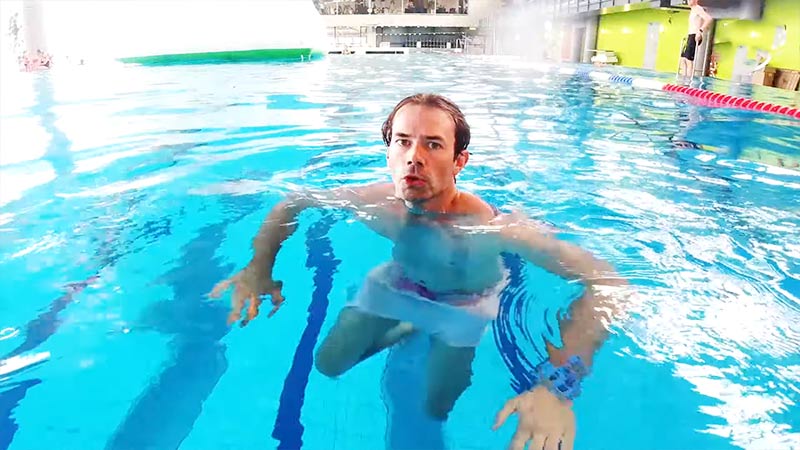Many of us eagerly anticipate pool time, relishing the cool waters on hot summer days. But what happens when the skies open up, and rain disrupts our swimming plans? Is it safe to dive in after a downpour?
This blog post explores the safety considerations and best practices for post-rain pool swimming. Rainwater can bring challenges, affecting the chemical balance, introducing contaminants, and raising safety concerns.
However, with proper maintenance and precautions, swimming in a pool after rain can remain an enjoyable and safe activity.
We will delve into the steps you need to take to ensure your pool’s water quality and clarify common misconceptions.
From water testing to shock treatments and safety measures, we will guide you through the essential knowledge to keep your pool pristine and ready for a refreshing dip even after the rain.
Is It Safe to Swim in a Pool After Rain?
It’s always a common question whether can you swim in a pool after it rains. Swimming in a pool after rain is generally safe, but there are some considerations to keep in mind:
Chemical Balance
Rainwater can alter the chemical balance of a pool by diluting the chlorine and other pool chemicals. This can potentially lead to an increased risk of bacterial growth and algae formation.
After heavy rain, it’s a good idea to check and adjust the pool’s chemical levels to ensure proper sanitation.
Contaminants
Rain can bring contaminants such as dirt, debris, and organic matter into the pool. It’s important to skim the surface and clean the pool as needed to remove these impurities.
Electrical Safety
Be cautious if there is lightning during or immediately after a rainstorm. Lightning poses a significant risk when swimming, so it’s best to wait until the storm has passed and the pool area is safe.
Water Clarity
After heavy rain, pool water may become cloudy due to the introduction of sediment and other impurities. You may need to run the pool’s filtration system for a longer period and possibly use pool clarifiers to restore water clarity.
Safety Precautions
Always practice good swimming safety, regardless of the weather. Be aware of slippery surfaces around the pool, and ensure that you and others are comfortable and competent swimmers.
Swimming in a pool after rain is generally safe as long as you take appropriate measures to maintain water quality and observe safety precautions.
Regular pool maintenance, including checking chemical levels and cleaning, is essential to ensure that your pool remains a safe and enjoyable environment for swimming.
Pool Water Filtration and Chlorination After Rain
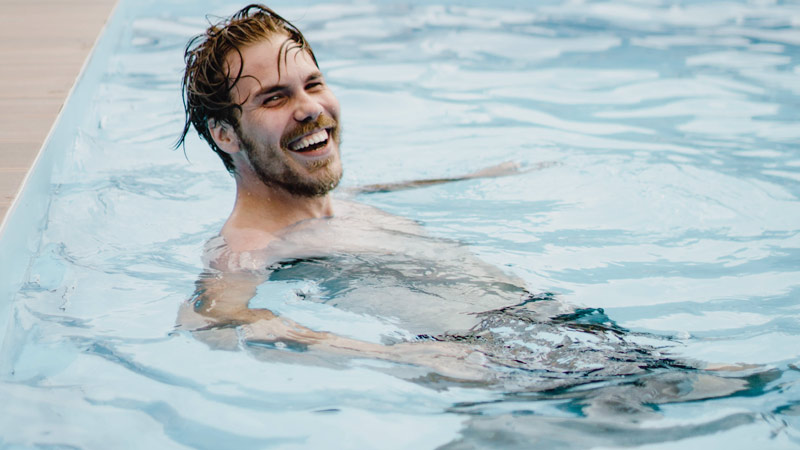
Whether is it safe to swim in rainwater often depends on the pool water filtration and chlorination. After heavy rain, it’s important to take specific steps to maintain the water quality and safety of your swimming pool.
Here are some guidelines for pool water filtration and chlorination after rain:
Check Chemical Levels
Test the water for chlorine, pH, alkalinity, and other chemical levels using a pool water testing kit.
Adjust the pH and alkalinity levels if necessary to keep them within the recommended range. The ideal pH range for pool water is typically between 7.2 and 7.6.
Shock the Pool
After heavy rain, it’s a good idea to “shock” the pool by adding a higher dose of chlorine. This helps to kill any contaminants that may have entered the pool from rainwater and prevents the growth of bacteria or algae.
Run the Filtration System
Increase the running time of your pool’s filtration system to help remove debris and contaminants introduced by the rain. Running the pump and filter for an extended period can improve water clarity.
Skim the Surface
Use a pool skimmer to remove leaves, debris, and other contaminants that may have floated on the pool’s surface during the rain.
Vacuum and Clean
Vacuum the pool to remove sediment and dirt that may have settled on the pool floor. Clean the pool walls and surfaces as needed to maintain water clarity and cleanliness.
Use Clarifiers
If the water remains cloudy despite these efforts, you can use pool water clarifiers to improve water clarity.
Monitor and Repeat
Continue to monitor the pool’s chemical levels and water quality regularly, especially in the days following heavy rain. You may need to repeat some of these steps if the water quality deteriorates.
Rain Covers and Pool Enclosures
Consider using a pool cover or enclosure to prevent rainwater from directly entering the pool. This can reduce the need for extensive post-rain maintenance.
By following these steps, you can help ensure that your pool water remains safe and clean after heavy rain. Regular pool maintenance and water testing are essential to keep your pool in good condition, no matter the weather conditions.
Best Practices for Post-Rain Pool Swimming
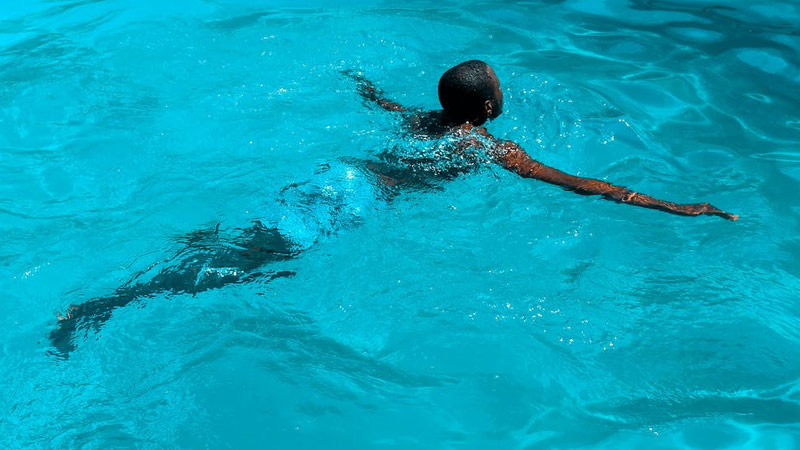
Swimming in a pool after rain requires some post-rain best practices to ensure safety and water quality. Here are seven points with detailed explanations:
Water Testing
Use a pool water testing kit to check the chemical balance of the pool water. Confirm that the chlorine, pH, alkalinity, and other chemical levels are within the recommended ranges.
This step is crucial to ensure the water is safe for swimming.
Adjust Chemical Levels
If necessary, adjust the chemical levels. You may need to add chlorine to ensure proper sanitation. Also, adjust the pH and alkalinity to maintain water balance, typically within the range of 7.2 to 7.6 pH.
Shock Treatment
After rain, introduce a shock treatment to the pool. This means adding a higher dose of chlorine to eliminate contaminants that might have entered the pool with the rainwater. This step helps prevent the growth of bacteria and algae.
Filtration and Circulation
Increase the runtime of your pool’s filtration system to help remove debris and impurities that enter the pool during the rain. Proper filtration ensures that the water remains clean and clear.
Surface Skimming
Use a pool skimmer to remove leaves, debris, and any contaminants that have accumulated on the water’s surface due to rain. Regular skimming keeps the pool clean and makes it more enjoyable to swim in.
Cleaning and Vacuuming
After heavy rain, there may be sediment and dirt on the pool floor. Vacuum the pool to remove these impurities. Additionally, clean the pool walls and surfaces as needed to maintain water clarity and cleanliness.
Regular Monitoring
Keep an eye on the pool’s chemical levels, water clarity, and overall cleanliness in the days following rain.
You may need to repeat some of the above steps if the water quality deteriorates. Consistent monitoring and maintenance are key to enjoying a clean and safe pool.
Incorporating these best practices into your post-rain pool routine will help ensure that your pool water remains inviting and free of contaminants, making it safe and enjoyable for swimming.
Regular maintenance and attention to water quality are essential to keep your pool in excellent condition.
Maintaining Pool Water Balance after Rain
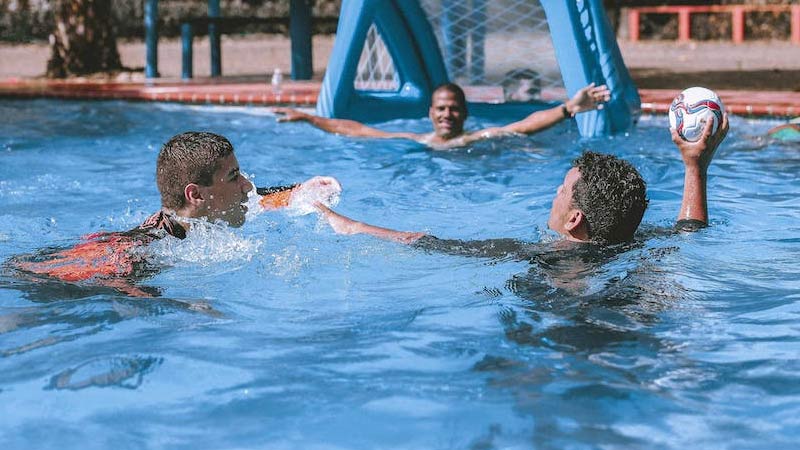
Maintaining proper pool water balance after rain is essential to ensure water quality and swimmer safety. Here are the key steps to follow:
Test Water Chemistry
Use a pool water testing kit to check the chemical levels in the pool water. Test for chlorine, pH, alkalinity, calcium hardness, and cyanuric acid (if applicable).
Adjust pH and Alkalinity
After heavy rain, the pH level of the pool water may be affected. If the pH is outside the recommended range of 7.2 to 7.6, adjust it with pH increaser (to raise pH) or pH reducer (to lower pH).
Alkalinity should be maintained within the 80-120 ppm range. Proper pH and alkalinity levels ensure swimmer comfort and prevent corrosion or scale formation.
Check Chlorine Levels
Test the chlorine level in the pool. Rain can dilute chlorine, making it less effective. Add chlorine as needed to maintain the appropriate level for your pool type (typically 1-3 ppm for free chlorine).
Calcium Hardness
Check the calcium hardness level, especially in areas with soft water. The recommended range is typically 200-400 ppm. Adjust using calcium chloride if necessary.
Stabilizer (Cyanuric Acid)
If you use stabilized chlorine (chlorine with cyanuric acid), check the cyanuric acid level. The ideal range is 30-50 ppm. Add cyanuric acid if needed, but avoid overdoing it, as excessive levels can reduce chlorine effectiveness.
Super Chlorination (Shock Treatment)
After heavy rain, it’s a good practice to shock the pool. This means adding a higher dose of chlorine to help eliminate any contaminants introduced by the rainwater and to prevent algae growth.
Follow the manufacturer’s instructions for your specific pool shock treatment product.
Filtration and Circulation
Run the pool’s filtration system for an extended period to help remove debris and contaminants from the water. Circulating the water through the filter is crucial for maintaining water clarity.
Regular Maintenance
Continue with your regular pool maintenance routine. Skim the pool’s surface to remove debris, vacuum the pool floor to eliminate sediment, and brush the pool walls to prevent algae growth.
Monitor Water Quality
After performing these steps, regularly monitor the water quality and chemical levels. Be prepared to make adjustments if needed to maintain proper balance.
Preventive Measures
Consider using pool covers or enclosures to minimize the introduction of rainwater and debris into the pool, especially during heavy rainstorms.
Consistent monitoring and maintenance are essential for keeping your pool water balanced, clear, and safe for swimming after rain. Following these steps will help you enjoy your pool without concerns about water quality or safety.
Safety Precautions About Swimming in Pool After Rain
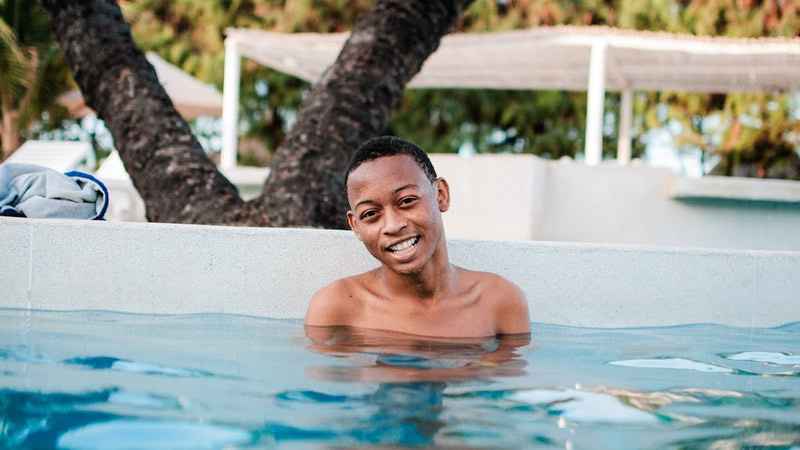
Swimming in a pool after rain is generally safe, but there are some important safety precautions to keep in mind to ensure the well-being of swimmers:
- Chemical Balance Check: After rain, it’s crucial to test the pool water for proper chemical balance. Ensure that the pH, chlorine levels, and other chemical parameters are within the recommended ranges.
- Shock Treatment: Consider performing a shock treatment on the pool water to eliminate contaminants introduced by rain and to prevent the growth of bacteria and algae.
- Electrical Safety: Wait for a safe period after a rainstorm if there is lightning in the area. Water is a conductor of electricity, and swimming during a thunderstorm poses a significant risk of lightning strikes.
- Water Clarity: Ensure that the pool water is clear and free from debris. Use pool skimmers to remove leaves, branches, and any other floating debris that might have entered the pool during the rain.
- Slippery Surfaces: Be cautious of slippery surfaces around the pool deck, especially if it’s made of materials that become slick when wet. Slips and falls can result in injuries, so walk carefully and consider using non-slip footwear if needed.
- Supervision: Always maintain proper supervision of swimmers, especially if there are children or inexperienced swimmers in the pool. Even after rain, water conditions can change, and swimmers should be monitored for their safety.
- Hydration: Rain and swimming can make people forget to stay hydrated. Make sure swimmers, especially children, are drinking water to avoid dehydration, even in the pool.
- Educate Swimmers: Ensure that everyone in the pool is aware of the potential changes in pool conditions due to rain, such as reduced visibility and different water temperatures. Educate swimmers on how to handle these changes safely.
- Prevent Contamination: Encourage swimmers to shower before entering the pool, which can help minimize the introduction of contaminants into the water.
- Weather Forecast: Keep an eye on the weather forecast and be prepared to evacuate the pool if another rainstorm is approaching or if there is any sign of severe weather.
By following these safety precautions, you can enjoy swimming in a pool after rain while minimizing the risks associated with changing water conditions and maintaining a safe and enjoyable environment for all swimmers.
FAQs
Can I use a public swimming pool after rain?
Yes, you can use a public swimming pool after rain, but it’s essential to wait for a short period after the rain stops to ensure that any contaminants washed into the pool are properly diluted and filtered.
Follow the pool management’s guidelines for reopening after rain to ensure safety.
Is it okay if rainwater mixes with the pool water?
It’s generally okay for rainwater to mix with pool water to some extent, as it can help maintain water levels. However, excessive rainfall can dilute pool chemicals and affect water balance.
Proper pool maintenance and filtration systems are necessary to manage this and maintain water quality.
Is it safe to swim in the rain in a pool?
Swimming in the rain is generally safe, as long as there are no lightning storms or other dangerous weather conditions. Rain can add a unique and enjoyable experience to swimming.
However, always exercise caution and be aware of any changes in weather conditions while in the pool.
Can you swim in rainwater?
Swimming in natural rainwater, such as in a lake, pond, or river, is possible but not always advisable. It depends on the water source’s quality and safety.
Rainwater can contain pollutants and contaminants from the atmosphere, so it’s crucial to ensure the water is clean and safe for swimming.
Is it safe to swim in a pool after rain?
Swimming in a pool after rain can be safe if proper precautions are taken. Wait for the rain to stop, and for the pool management to assess and adjust chemical levels.
Rain can introduce contaminants, so ensuring the pool is properly maintained and water quality is tested is essential for safety.
Wrapping Up
Enjoying your pool after a rain shower is indeed possible, but it requires diligence and proper care.
Understanding the impact of rain on pool water quality and following essential steps such as chemical balance checks, shock treatments, and safety precautions can help maintain a clean and safe swimming environment.
Remember that maintaining water quality and safety is an ongoing process, and regular testing, filtration, and cleaning are key.
By adhering to these guidelines, you can continue to enjoy your pool throughout the summer and ensure that every swim after a rainstorm is a refreshing and worry-free experience.
With the right knowledge and practice, you can make the most of your pool, rain or shine, while keeping the well-being of swimmers a top priority.

